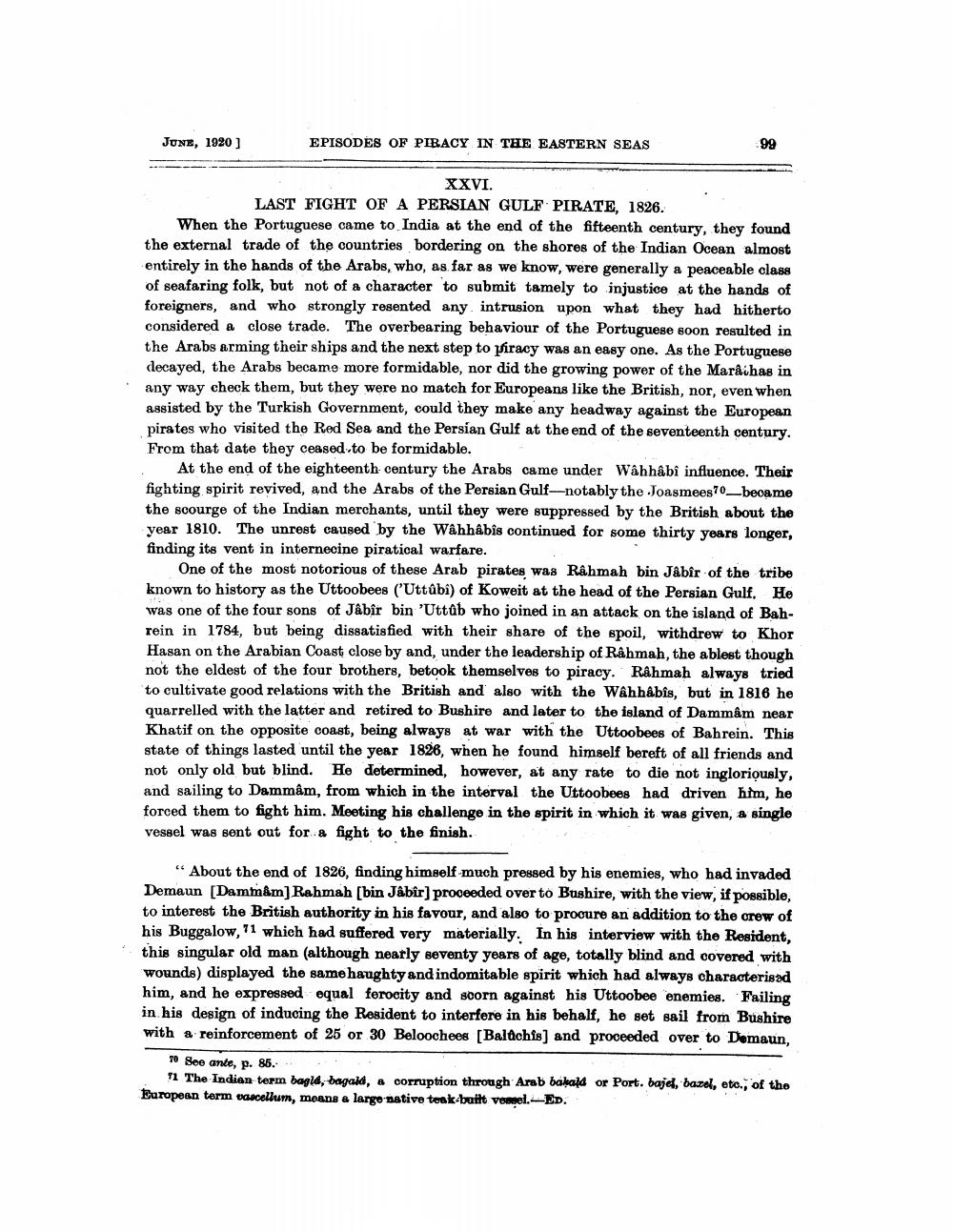________________
JUNE, 1920 ]
EPISODES OF PIRACY IN THE EASTERN SEAS
XXVI. LAST FIGHT OF A PERSIAN GULF PIRATE, 1826. When the Portuguese came to India at the end of the fifteenth century, they found the external trade of the countries bordering on the shores of the Indian Ocean almost entirely in the hands of the Arabs, who, as far as we know, were generally a peaceable class of seafaring folk, but not of a character to submit tamely to injustice at the hands of foreigners, and who strongly resented any intrusion upon what they had hitherto considered a close trade. The overbearing behaviour of the Portuguese soon resulted in the Arabs arming their ships and the next step to piracy was an easy one. As the Portuguese decayed, the Arabs became more formidable, nor did the growing power of the Maraihas in any way check them, but they were no match for Europeans like the British, nor, even when assisted by the Turkish Government, could they make any headway against the European pirates who visited the Red Sea and the Persian Gulf at the end of the seventeenth century. From that date they ceased to be formidable.
At the end of the eighteenth century the Arabs came under Wahhabi influence. Their fighting spirit revived, and the Arabs of the Persian Gulf--notably the Joasmees70_became the scourge of the Indian merchants, until they were suppressed by the British about the year 1810. The unrest caused by the Wâhhâbîs continued for some thirty years longer, finding its vent in internecine piratioal warfare.
One of the most notorious of these Arab pirates was Rahmah bin Jabir of the tribe known to history as the Uttoobees ('Uttûbi) of Koweit at the head of the Persian Gulf. He was one of the four sons of Jâbîr bin 'Uttûb who joined in an attack on the island of Bahrein in 1784, but being dissatisfied with their share of the spoil, withdrew to Khor Hasan on the Arabian Coast close by and, under the leadership of Rahmah, the ablest though not the eldest of the four brothers, betook themselves to piracy. Rahmah always tried to cultivate good relations with the British and also with the Wahhabis, but in 1816 he quarrelled with the latter and retired to Bushire and later to the island of Dammâm near Khatif on the opposite coast, being always at war with the Uttoobees of Bahrein. This state of things lasted until the year 1826, when he found himself bereft of all friends and not only old but blind. He determined, however, at any rate to die not ingloriously, and sailing to Dammâm, from which in the interval the Uttoobees had driven him, he forced them to fight him. Meeting his challenge in the spirit in which it was given, a single vessel was sent out for a fight to the finish.
“About the end of 1826, finding himself much pressed by his enemies, who had invaded Demaun [Dammâm]Rahmah (bin Jabir) proceeded over to Bushire, with the view, if possible, to interest the British authority in his favour, and also to procure an addition to the crew of his Buggalow, 11 which had suffered very materially. In his interview with the Resident, this singular old man (although nearly seventy years of age, totally blind and covered with wounds) displayed the same haughty and indomitable spirit which had always characterisad him, and he expressed equal ferocity and scorn against his Uttoobee enemies. Failing in his design of inducing the Resident to interfere in his behalf, he set sail from Bushire with a reinforcement of 25 or 30 Beloochees (Baldchis] and proceeded over to Demaun,
To See ante, p. 85.
11 The Indian term bagla, bagaid, a corruption through Arab bahald or Port. bajd, bazel, etc., of the European term vascellum, means & large native teak-butt venel.ED.




